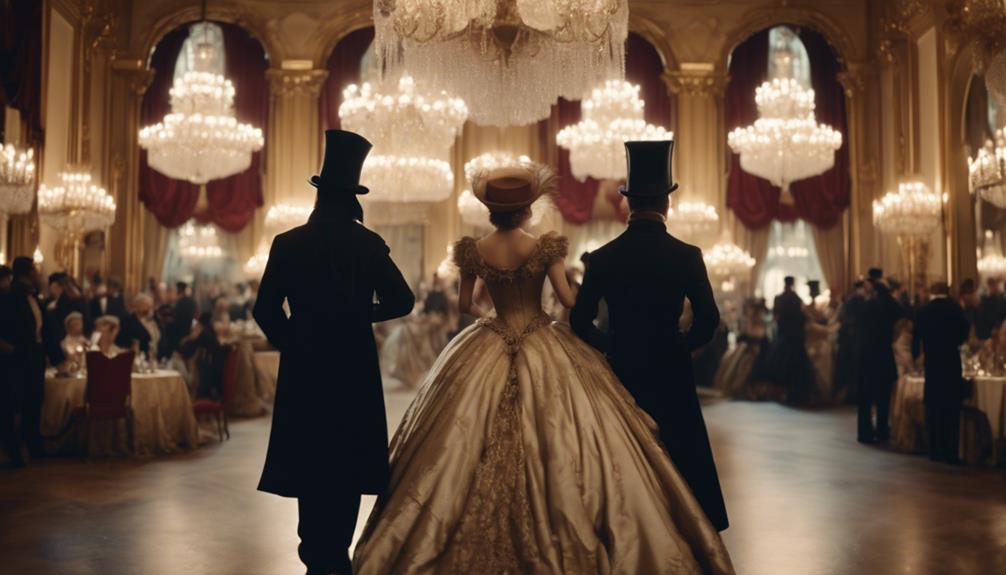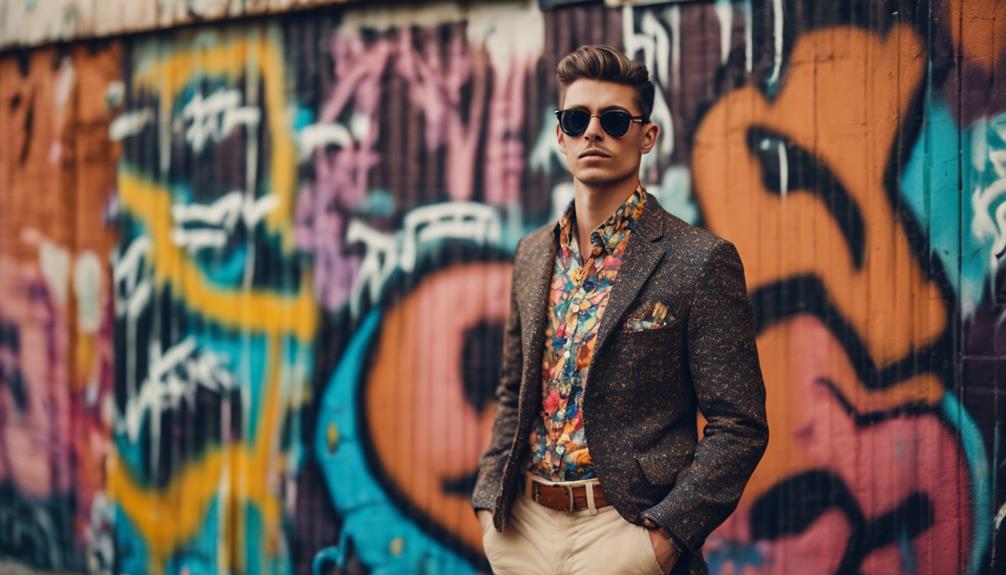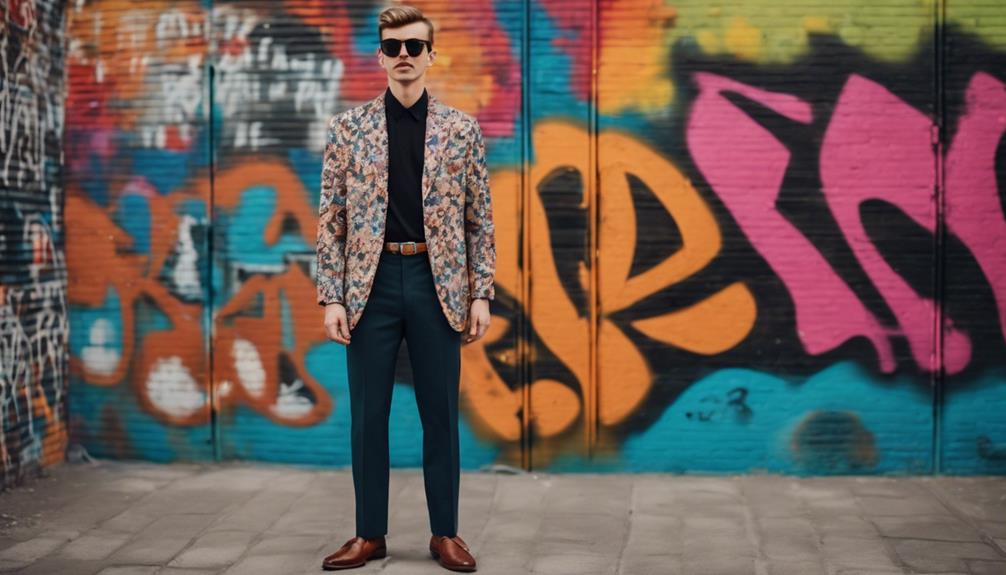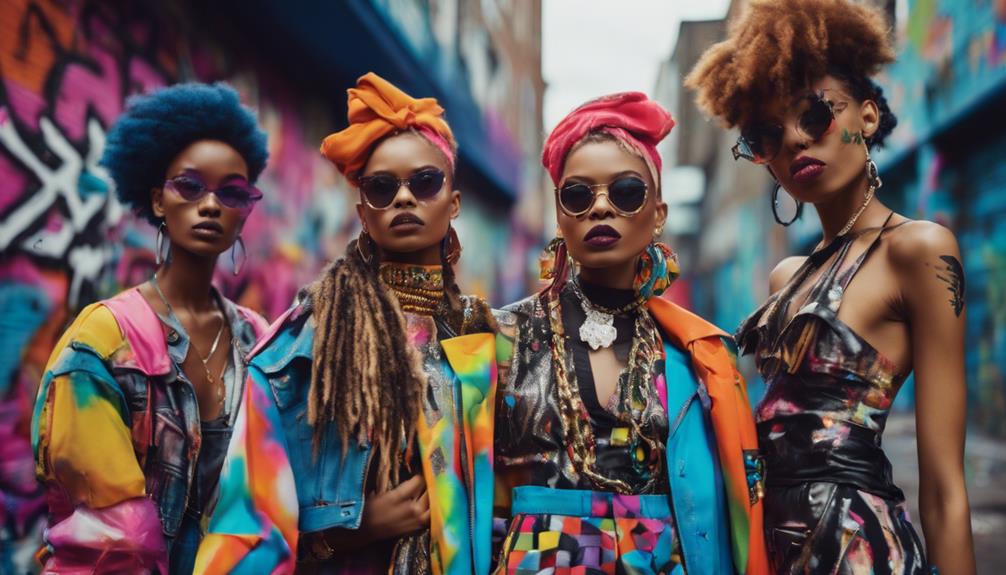The fashion of the Gilded Age showcases the extravagant styles of the late 19th century, emphasizing wealth and social status. Opulent fabrics like rich velvet and lustrous silk, adorned with intricate embroidery and lace, were common. The era featured dramatic silhouettes such as the hourglass figure and tailored suits. Men wore looser fits and tuxedos for formal occasions, while women embraced luxurious evening gowns with elaborate embellishments. Modern designers continue to celebrate this vintage glamour by creating contemporary pieces inspired by these historical styles. If you’re curious about the cultural impact and styling tips, there’s much more to discover!
Key Takeaways
- The Gilded Age featured opulent fabrics like velvet and silk, which were symbols of wealth and status among the elite.
- Intricate embroidery and lace, including styles like Chantilly, enhanced the luxurious appearance of women's attire during this era.
- The Art Nouveau movement influenced fashion with flowing lines and nature-inspired designs, moving away from rigid Victorian structures.
- Contemporary designers have revived Gilded Age styles, incorporating corsets and bustles to celebrate vintage glamour in modern collections.
Origin and historical background of the fashion trend/style
The Gilded Age marked a pivotal shift in fashion, reflecting the era's economic boom and the rise of a wealthy elite.
You'll notice how styles evolved through the decades, influenced by movements like Art Nouveau, which embraced new artistic expressions in clothing.
This transformation not only changed what people wore but also how they viewed fashion as a symbol of status and individuality.
Fashion's Transition Through Decades
Fashion during the Gilded Age transformed dramatically, showcasing extravagant styles and luxurious materials that set the stage for modern clothing trends. This era, spanning from 1870 to 1900, was pivotal for women's fashion.
You'd witness the evolution from the dramatic silhouettes of the Victorian Bustle Era in the 1870s to the more refined princess line introduced in 1876. This shift emphasized vertical seams, creating a streamlined look that was a departure from previous styles.
As you moved into the 1880s, fashion trends began to idealize the hourglass figure, with smaller bustles gaining popularity. Men's fashion also underwent significant changes, moving from tailored suits to looser fits and the widespread acceptance of tuxedos for formal occasions.
The Aesthetic Dress Movement emerged, promoting less restrictive clothing and influencing the acceptance of non-corseted styles, reflecting changing societal norms.
Art Nouveau Movement
Emerging in the late 19th century, the Art Nouveau movement reacted against traditional artistic norms, introducing a fresh wave of creativity that profoundly impacted fashion. This movement, which blossomed around the 1890s, emphasized organic forms and flowing lines, steering away from the rigid structures of the past.
Designers like Alphonse Mucha and Paul Poiret played pivotal roles, infusing mens and womens fashion with intricate, nature-inspired designs. You'd find garments adorned with floral motifs, curvilinear shapes, and asymmetrical patterns, making each piece a celebration of the natural world.
The Art Nouveau aesthetic thrived on vibrant colors and innovative textile techniques, showcasing the union of art and fashion. Moreover, Art Nouveau promoted the concept of 'total design,' where fashion seamlessly intertwined with architecture and decorative arts.
This holistic approach led to a cohesive artistic expression across various mediums, fundamentally altering how you perceive style. The rise of the 'Liberty Style' in textiles epitomized this shift, celebrating the feminine form with soft fabrics and elaborate prints.
In this way, the Art Nouveau movement not only transformed fashion but also redefined artistic boundaries during the Gilded Age.
Key Characteristics
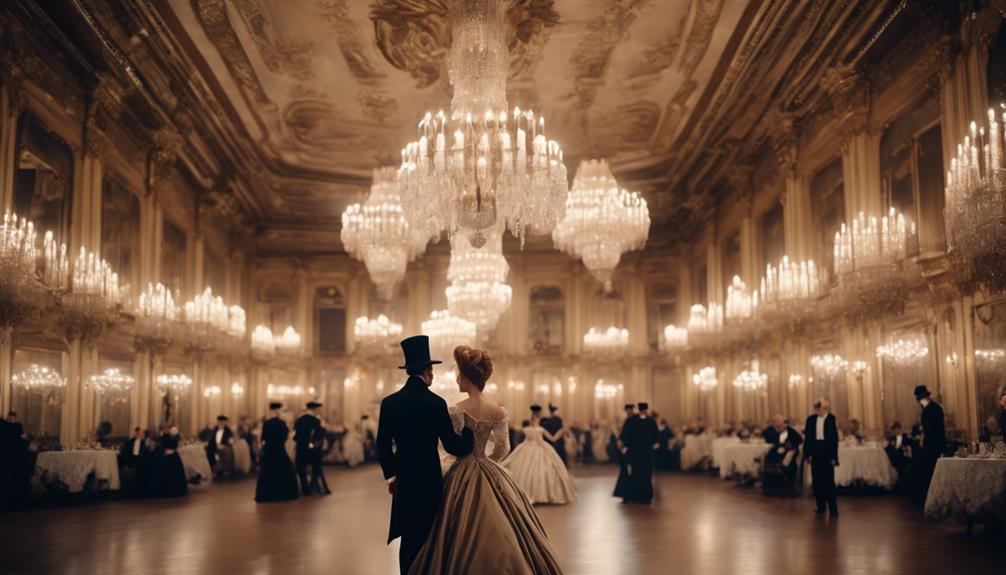
When you think about Gilded Age fashion, opulent embroidery and lace immediately come to mind, showcasing a love for intricate detail.
Rich velvet and silk fabrics created a luxurious feel, while brocade evening gowns served as the ultimate statement pieces for formal events.
These key characteristics not only highlighted wealth but also reflected the era's obsession with grandeur and elegance.
Opulent Embroidery and Lace
Opulent embroidery and lace defined Gilded Age garments, showcasing intricate floral designs and luxurious metallic threads that reflected the wearer's wealth and status.
You'd notice how these embellishments transformed dresses into works of art, often featuring hand-stitched details that highlighted the craftsmanship of skilled dressmakers. Lace became a favored addition, with styles like Chantilly and Venetian lace enhancing the elegance of women's attire.
In the 1880s, dresses often included lavish layers of lace, frills, and ruffles, creating a visually striking appearance that emphasized the hourglass silhouette. You'll see how the use of contrasting lace trims along hemlines, bodices, and sleeves added depth and texture, making each outfit more luxurious.
These garments weren't just clothing; they were symbols of status and refinement. Wealthy women wore opulent embroidery and lavish lace as a clear indication of their affluence.
Every detail mattered, and the combination of delicate lace with intricate embroidery elevated Gilded Age fashion to new heights, showcasing a period where style was synonymous with opulence and prestige.
Rich Velvet and Silk
Rich velvet and silk became staple fabrics of the Gilded Age, embodying the era's lavish style and enhancing the grandeur of both women's and men's fashion.
You'll find that rich velvet, with its deep hues and plush texture, was often chosen for evening gowns and cloaks, creating a striking visual impact as it caught the light. This luxurious fabric not only elevated the elegance of the garments but also provided warmth, making it a favorite for upper-class social events.
Silk, on the other hand, is renowned for its lustrous sheen and graceful drape. You'd see it frequently utilized in women's dresses and men's formal wear, like tuxedos. The versatility of silk allowed for a variety of styles, from flowing gowns to sharply tailored suits.
The combination of rich velvet and silk also paved the way for intricate embellishments, such as lace, embroidery, and beadwork, amplifying the extravagance of the clothing.
As advancements in textile production made these luxury materials more accessible, they became essential to the fashion of the Gilded Age, reflecting the era's obsession with wealth and sophistication.
Brocade Evening Gowns
Brocade evening gowns feature intricate, raised patterns woven into luxurious fabrics like silk or velvet, instantly signaling wealth and status during the Gilded Age. These gowns are designed with a structured silhouette, providing a fitted bodice that flows into a full skirt, often enhanced with bustles for added drama. This design not only accentuates your waist but also creates an opulent appearance that draws attention.
When you wear a brocade evening gown, you'll appreciate the elaborate embellishments that often accompany these stunning pieces. Lace, ribbons, and jewels adorn the gowns, showcasing your attention to detail and love for extravagance. The color palette is equally mesmerizing, with choices ranging from rich jewel tones to striking metallic shades, perfectly reflecting the era's fascination with vibrant hues.
To complete your look, you can pair your brocade evening gown with accessories like gloves, ornate jewelry, and feathered hats, enhancing the luxurious vibe that defines high-society events of the Gilded Age. Embracing this style allows you to step into a world of elegance and sophistication, where fashion truly signifies status.
Modern Interpretation
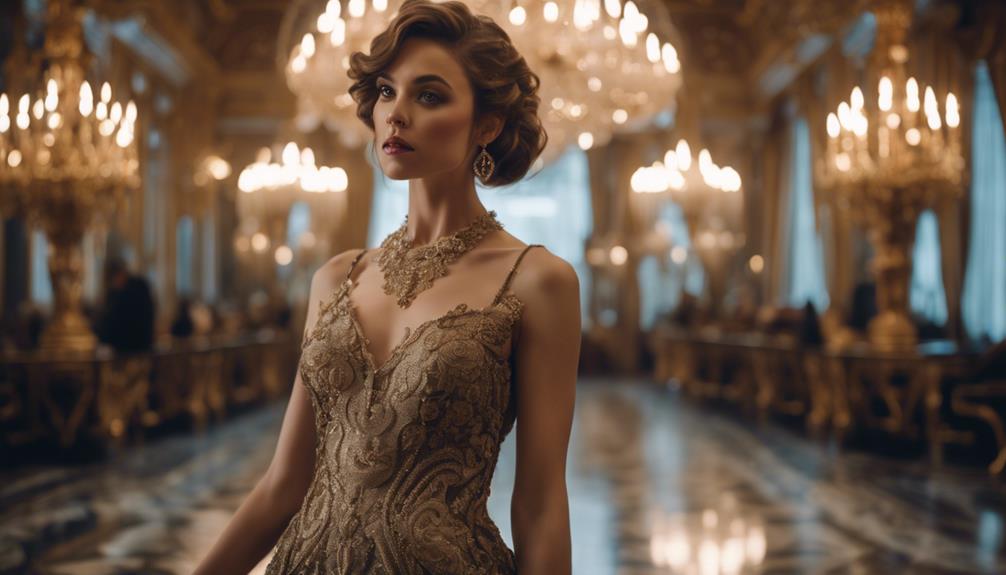
You can see how modern designers are reimagining Victorian silhouettes, bringing a fresh twist to Gilded Age aesthetics.
By highlighting the work of notable couturiers and celebrating fashion icons from that era, today's collections echo the grandeur of the past.
This revival not only captures the essence of vintage glamour but also influences current consumer preferences.
Revival of Victorian Silhouettes
Modern fashion reimagines Victorian silhouettes by integrating corsets, long bodices, and dramatic skirts, combining historical opulence with contemporary comfort. Designers draw inspiration from the Gilded Age, reviving the lavish textures of silk, lace, and tulle typical of 19th-century gowns. The result? A fresh take on the hourglass figure that emphasizes femininity while accommodating modern lifestyles.
You'll notice that the revival of bustles and puffy sleeves in current styles creates volume and flair, much like the extravagant dresses of the past. This blend of vintage and modern not only pays homage to history but also reinvents it for today's fashion-savvy individuals.
Accessories play an essential role, too. Pairing vintage-inspired gloves and ornate jewelry with contemporary outfits bridges the gap between eras, allowing you to express your unique style while nodding to the past.
Media portrayals, particularly in popular shows like 'Bridgerton,' have sparked a renewed interest in Victorian silhouettes, encouraging designers to explore historical influences. As you embrace these trends, you'll find that Gilded Age fashion continues to inspire and transform the way you dress today.
Notable Gilded Age Couturiers
Inspired by the opulent designs of Gilded Age couturiers, today's fashion scene reflects their enduring influence while embracing innovative techniques and sustainability. Renowned figures like Charles Frederick Worth, often hailed as the father of haute couture, laid the groundwork for modern fashion. His House of Worth not only set trends but also introduced the concept of seasonal collections, forever changing how you view fashion.
Contemporary designers draw from the lavish embroidery and rich fabrics that defined the Gilded Age. The intricate textiles and patterns popularized by Liberty & Co. continue to inspire today's collections, emphasizing craftsmanship and design integrity. You can see echoes of the Aesthetic Dress Movement in modern garments that prioritize comfort while rejecting restrictive silhouettes.
Today's couturiers are reinventing the elaborate silhouettes of the past, merging them with sustainable practices to create garments that honor tradition while addressing contemporary needs. As you explore modern haute couture, keep an eye out for those nods to the Gilded Age, where grandiosity meets innovation, showcasing a marriage of history and modernity in every stitch.
Fashion Icons of the Era
Celebrating the bold styles of Gilded Age fashion icons, today's designers reinterpret their lavish elegance with a contemporary twist. Designers draw inspiration from figures like Charles Frederick Worth, who pioneered haute couture and introduced branding in dressmaking. His influence persists, as modern fashion designers leverage signature styles to create distinctive collections that echo the opulence of the past.
Empress Eugenie of France remains a symbol of Gilded Age glamour, her extravagant wardrobe still inspiring today's trends. Similarly, the Aesthetic Dress Movement, led by Liberty & Co., promotes comfortable garments that challenge historical norms, reshaping women's fashion in innovative ways.
Socialites like Caroline Astor and Alva Vanderbilt epitomized the era's extravagant taste, showcasing elaborate dresses adorned with lace and silk. Today's fashion world embraces that spirit, with designers incorporating intricate details into their collections.
It's essential to acknowledge the contributions of women of color, like Ann Lowe, who crafted Jackie Kennedy's iconic wedding gown. As you explore modern interpretations, you'll find that Gilded Age fashion continues to influence and elevate today's women's fashion, celebrating both its heritage and evolution.
Styling Tips
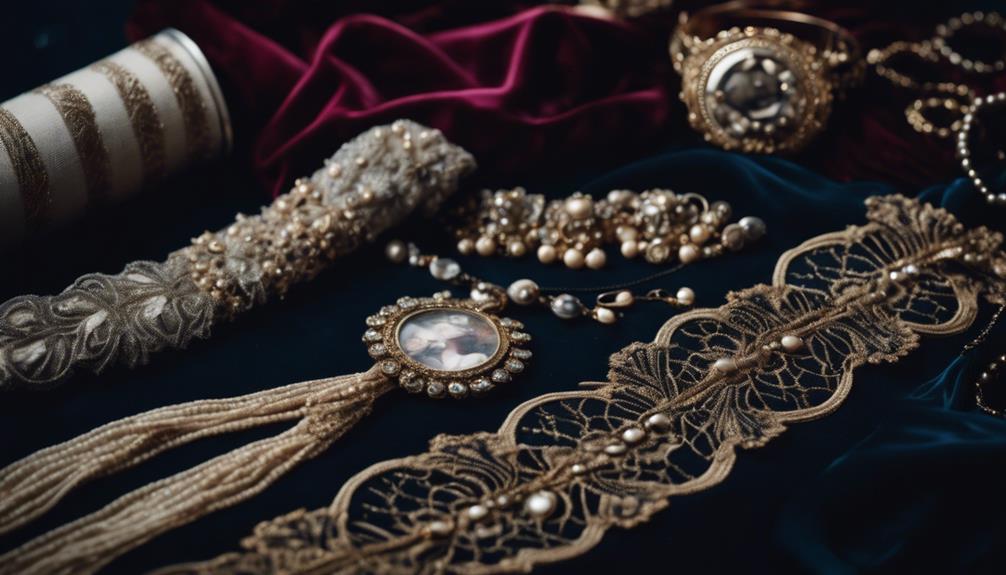
When you're aiming for that authentic Gilded Age look, focus on selecting the right corsets and bustles to shape your silhouette.
Pair these with Victorian-inspired evening wear to truly capture the essence of the era.
Don't forget to layer fabrics and textures for a rich, opulent finish that showcases your style.
Corsets and Bustles Selection
Corsets and bustles can transform your outfit into a stunning homage to Gilded Age fashion, creating a striking hourglass silhouette that flatters your figure. To incorporate these elements into your wardrobe, start with a well-fitted corset that enhances your natural shape. Look for styles featuring intricate lace and boning to capture the era's elegance. Pair your corset with a high-waisted skirt or dress to echo the fashionable silhouettes of the Gilded Age while keeping your look modern.
When it comes to bustles, consider adding one that complements your outfit's overall vibe. Whether you prefer a small, subtle bustle or a large, dramatic shape, both options can add volume and flair to your ensemble. Materials like horsehair or crinoline can offer the structure you need.
Don't forget the accessories! Pair your corseted gown and bustled skirt with elegant gloves and a stylish hat to complete the opulent look characteristic of the period. With these styling tips, you'll embrace the grandeur of Gilded Age fashion while making it your own.
Victorian-Inspired Evening Wear
Victorian-inspired evening wear embraces elegance with floor-length gowns that feature intricate lace, frills, and bows, creating a stunning visual impact. To achieve the quintessential Victorian silhouette, don't forget to incorporate a corset. This essential piece will accentuate your waist and provide the structure needed to support elaborate skirts and dresses.
When selecting your evening wear, opt for fabrics like silk, tulle, or velvet to add richness and texture that reflect the opulence of the Gilded Age. You can also modernize your look by incorporating elements like bustles or the princess line, which maintain the historical roots while giving a contemporary flair.
Accessories can elevate your outfit further. Consider adding long gloves, which elongate your arms and enhance the overall elegance, or a jeweled brooch that adds a touch of sparkle. Feathered headdresses can also provide an extravagant finishing touch.
Layering Fabrics and Textures
To master the art of layering fabrics and textures in Gilded Age fashion, start by combining luxurious silks with delicate lace to create a striking visual contrast. This technique not only adds depth but also elevates your extravagant gowns to new heights.
Don't forget about the power of volume; incorporating bustles and petticoats can accentuate your waist while adding shape, mirroring the iconic hourglass silhouette of the 1880s.
When layering fabrics, focus on mixing textures—smooth silks with rougher lace enhance visual interest and reflect the era's love for opulence.
For a complete look, pay attention to detail with accessories like gloves, shawls, and elaborate hats. These items don't just finish your ensemble; they embody the wealth and sophistication of the time.
Men can also embrace layering by choosing tailored suits that combine multiple fabric types. Vests and waistcoats can add dimension, creating a polished appearance.
Remember, the key to successful layering is balance; guarantee that each layer complements the others while showcasing your unique style.
With these tips, you'll channel the grandeur of Gilded Age fashion effortlessly.
Shopping Guide
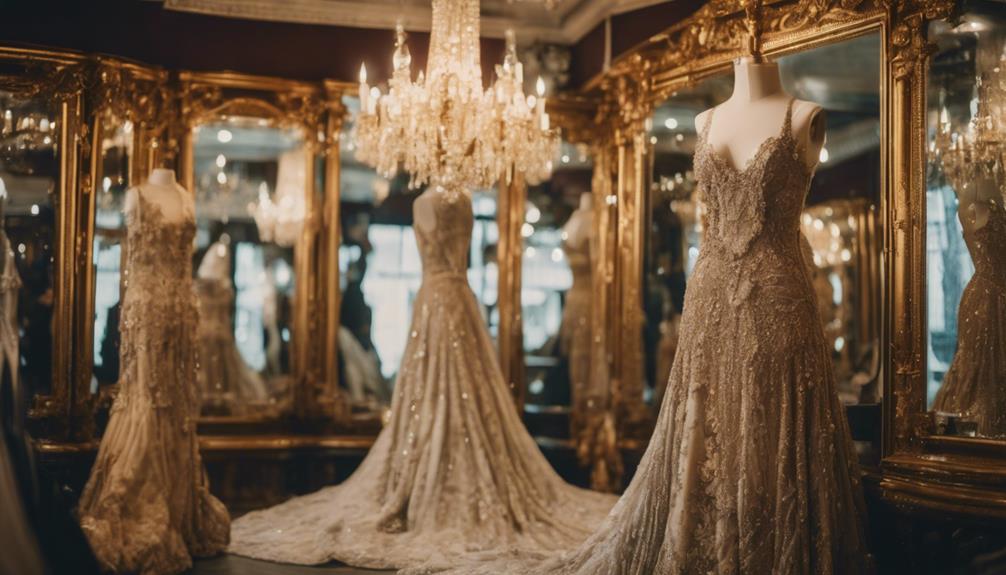
When diving into Gilded Age fashion, focus on key elements like corsets, bustles, and intricate lace that embody the era's opulence. These features are essential for recreating the lavish looks of the late 19th century. When shopping, consider investing in vintage or vintage-inspired pieces, as they often showcase the luxurious fabrics like silk, tulle, and velvet that were prevalent during this time.
Don't forget to accessorize! Gloves, elaborate hats, and statement jewelry can elevate your ensemble and echo the extravagant spirit of affluent families like the Vanderbilts. Look for boutiques and online retailers that specialize in historical fashion; they typically offer collections that feature adaptations of Gilded Age silhouettes and designs.
Also, keep an eye on modern fashion shows and exhibitions. Many contemporary designers draw inspiration from Gilded Age aesthetics, making it easier to find current pieces that resonate with this lavish style.
By exploring these avenues, you'll curate a wardrobe that not only captures the essence of the Gilded Age but also highlights your unique fashion sense.
Happy shopping!
Upcycling Vintage Fabrics
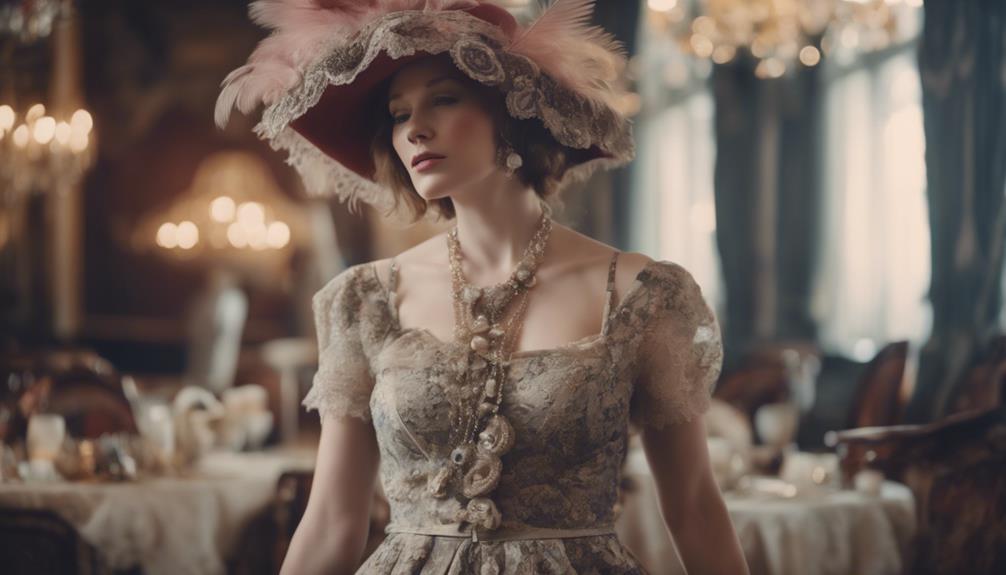
When you upcycle vintage fabrics, you're not just giving old textiles a second life; you're also embracing the rich history they carry.
Imagine incorporating delicate antique lace or unique button accents into your wardrobe, creating pieces that are both stylish and meaningful.
This approach not only showcases your creativity but also supports sustainable fashion practices.
Repurposing Antique Lace
Repurposing antique lace allows you to transform a piece of history into stunning modern creations that blend elegance with practicality. This beautiful fabric, often associated with Gilded Age styles, can be upcycled into garments, accessories, or home decor items that reflect both your personal taste and the intricate craftsmanship of the past.
By incorporating antique lace into your designs, you embrace sustainable fashion practices that reduce waste while celebrating historical artistry. Techniques like sewing, embroidery, and patchwork enable you to create unique pieces that stand out. Imagine an evening gown adorned with delicate lace details or a bridal veil that showcases the opulence of the Gilded Age, but with a contemporary twist.
Before you start, remember to carefully clean and restore the lace to maintain its delicate nature. This process not only preserves the fabric but also guarantees it's ready for your creative touch.
Whether you're a seasoned designer or a DIY enthusiast, repurposing antique lace offers endless possibilities to honor the past while making it relevant in today's fashion landscape. So gather your materials and let your imagination run wild!
Antique Button Accents
Antique button accents can transform upcycled vintage garments into stunning pieces that echo the elegance of the Gilded Age while showcasing your unique style. These buttons, often crafted from glass, metal, or porcelain, carry a rich history and add a distinctive touch to modern designs. By incorporating antique buttons, you not only preserve historical craftsmanship but also emphasize the luxurious aesthetic that defined past fashion trends.
When you upcycle vintage fabrics, the addition of antique buttons enhances the narrative of your garments. Each button tells a story, connecting your piece to the opulence and creativity of a bygone era. Look for buttons with intricate designs and embellishments that reflect the lavishness of the Gilded Age, making your fashion statement all the more remarkable.
This practice promotes sustainability and creativity, allowing you to breathe new life into forgotten textiles. As you select your antique buttons, consider how they'll complement the textures and patterns of your upcycled vintage garments.
With thoughtful choices, you can create unique, elegant pieces that stand out while honoring the craftsmanship of the past.
Cultural Impact
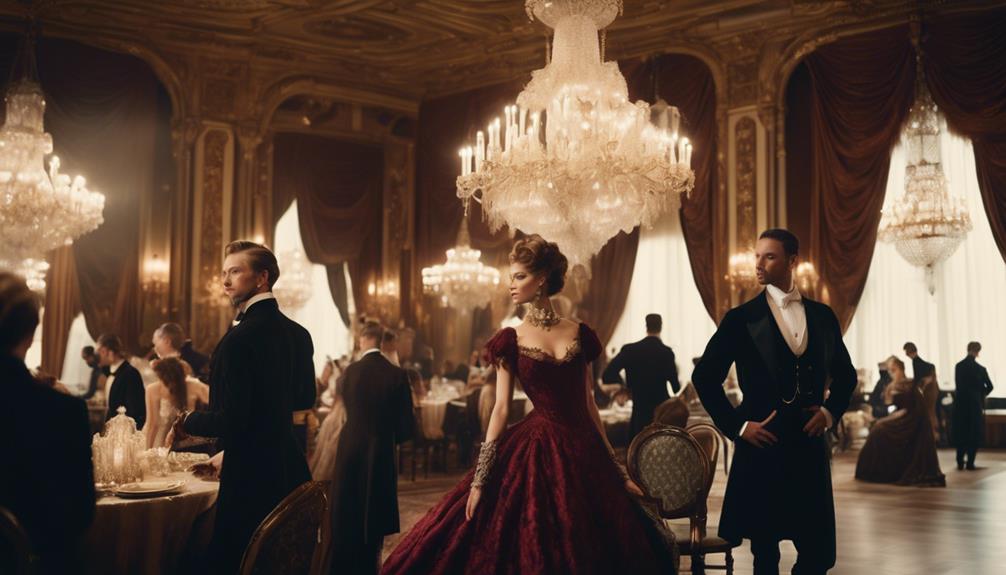
You can see Gilded Age fashion's cultural impact in modern films, where filmmakers often draw on its opulent styles to evoke a sense of wealth and social standing.
Additionally, the fashion of this era played a role in shaping the Women's Suffrage Movement, as women began to challenge restrictive clothing norms in their quest for freedom and equality.
Fashion in Modern Films
Modern films like 'Bridgerton' and 'The Gilded Age' have reignited interest in Gilded Age fashion, showcasing its extravagant designs and cultural significance. These productions immerse you in a world where clothing reflects opulence and social dynamics.
Costume designers draw inspiration from historical garments, using luxurious materials like silk and lace to create authentic looks that resonate with contemporary audiences.
As you watch these films, you can appreciate how Gilded Age fashion serves as a symbol of wealth and status, making you consider the deeper meanings behind what characters wear. This portrayal has sparked discussions about the cultural relevance of fashion, leading to a resurgence in modern trends that embrace vintage-inspired clothing and accessories reminiscent of that lavish era.
You might find yourself drawn to these styles, as they not only reflect a fascinating history but also influence your wardrobe choices today. The impact of Gilded Age fashion in cinema emphasizes its ongoing evolution and relevance, reminding you that clothing is more than just fabric—it's a powerful expression of identity and status in both past and present contexts.
Women's Suffrage Movement Influence
The Women's Suffrage Movement greatly reshaped fashion, encouraging women to embrace practical and comfortable clothing that symbolized their fight for freedom and equality. As activists like Susan B. Anthony and Elizabeth Cady Stanton challenged societal norms, they rejected the restrictive corsets that defined Gilded Age style. Instead, you'd see women wearing shirtwaist blouses and looser skirts, which allowed for greater mobility and comfort.
This shift in fashion was part of a broader cultural change, giving rise to the 'new woman' archetype. She valued independence and athleticism, which was reflected in the popularity of tailored outfits and sportswear during the 1890s. Dress reform societies played a vital role in this movement, advocating for styles that prioritized health and ease over the heavy fabrics and constricting garments of the past.
As women fought for political rights, their fashion choices became a form of expression and rebellion. By moving away from opulent, traditional feminine styles, they asserted their identities and challenged the expectations placed upon them.
In this way, the suffrage movement not only influenced politics but also left a lasting mark on women's fashion.
Frequently Asked Questions
What Were the Styles of the Gilded Age?
During the Gilded Age, you'd see women in elaborate floor-length gowns with bustles and men in tailored suits. Accessories like gloves and hats completed the look, reflecting the era's opulence and evolving fashion trends.
What Were Some Trends in the Gilded Age?
During the Gilded Age, you'd notice trends like elaborate gowns with bustles, tailored suits for men, and extravagant accessories. The princess line emerged, emphasizing streamlined silhouettes, while puffy sleeves and corset-free styles gained popularity.
What Were the Features of the Gilded Age Fashion?
Gilded Age fashion features extravagant gowns with bustles, corsets, and luxurious fabrics. Men's tailored suits and top hats exemplify formality, while accessories like gloves and jewelry complete the opulent look of the era.
What Were the Old Fashion Trends in the 1800s?
In the 1800s, you'd see women in layered gowns with bustles and corsets, while men wore tailored suits and top hats. Accessories like gloves and jewelry showcased social status, making fashion a statement of wealth.
How Did Hip-Hop Fashion of the Golden Era Influence Gilded Age Fashion?
During the gilded age, hip hop fashion styles from the golden era heavily influenced clothing trends. Baggy pants, flashy jewelry, and oversized jackets worn by hip hop pioneers were adopted by celebrities and trendsetters of the time. This fusion of streetwear with luxury fashion created a unique and iconic style.
What Influences from the Gilded Age Fashion Can Be Seen in Renaissance Fashion?
The influence of Gilded Age fashion can be seen in Renaissance fashion styles era through elaborate, ornate designs. The use of rich, luxurious fabrics and opulent accessories reflects the opulence of both eras. The emphasis on intricate detailing and form-fitting silhouettes also draws parallels between the two fashion movements.
Conclusion
To sum up, Gilded Age fashion offers a fascinating glimpse into a time of opulence and creativity.
You can embrace its extravagant styles by incorporating key characteristics into your wardrobe.
Whether you choose to upcycle vintage fabrics or shop for modern interpretations, there's a way for everyone to connect with this rich history.
So go ahead, let your style shine with the lavish spirit of the Gilded Age—after all, fashion is all about expressing who you are!
